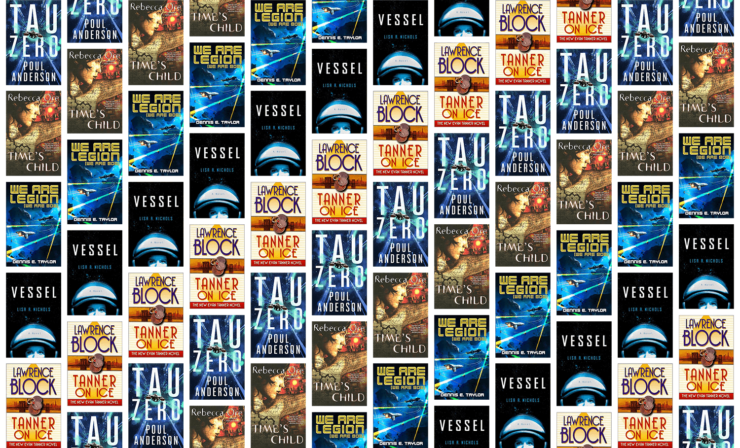Authors wishing to highlight noteworthy details of their cunningly crafted settings may encounter one vexing issue: for people raised in those milieus, there is nothing remarkable about them. The characters won’t comment on or explain things that puzzle us readers. Or at least they should not.
Introducing an outsider, especially one from an earlier point in history, provides useful perspective on the ways in which this new world differs from the past. It is not surprising, therefore, that SF authors have embraced a variety of ways to drop olden-time observers into futuristic worlds.
Here are five tried-and-true olden-time-observer insertion methods…
Probably the easiest approach is to have the character slumber the ages away. This classic method is well established, perhaps because it is such an obvious possibility. After all, who’s never slept in? The difference between oversleeping an hour or two or a century or ten is merely a matter of degree.
Lawrence Block’s 1999 Tanner on Ice is a somewhat paradoxical example, since Evan Tanner is notable for his inability to sleep thanks to a wartime injury. With eight extra hours a day to fill, Tanner became an international man of action for a certain agency. This thrilling life came to a very sudden halt on October 8th, 1972, when Tanner was duped, drugged, and put into suspended animation. The narrative begins again when Tanner is revived on March 14th, 1997, in a world that is quite different from the swinging Cold War he once knew. A world to which he will somehow have to adapt.
Relativity is a godsend to authors seeking convenient temporal displacement. Dispatch your traveler at near light speeds and when they return to Earth, they will discover their friends and family at home have lived through many more years than have the travelers themselves.
Consider the situation in which Boris Fedoroff (a supporting character in Poul Anderson’s 1970 Bussard ramjet classic Tau Zero) finds himself. For Fedoroff, the Delta Pavonis expedition took twelve years. On Earth, it would have lasted forty-three years. That time difference is short enough that the traveler’s native Russia is still (mostly) recognizable, but long enough that the society has evolved in ways to which the starfarer refuses to adapt.
Fedoroff turned to confront her. “We expected people would have died when we came home. We expected change. If anything, I was overjoyed at first that I could recognize parts of my city — moonlight on canals and river, domes and towers on Kazan Cathedral, Alexander and Bucephalus rearing over the bridge that carries Nevsky Prospect, the treasures in the Hermitage—” He looked back away and shook his head wearily. “But the life itself. That was too different.”
Happily, for Fedoroff, the expedition to Beta Virginis can use an experienced crew member like him. Not that this new expedition will go entirely to plan.
Authors not wishing to go to the bother of near-light-speed interstellar travel might cut out the middleman and resort to time travel. Ignore space, traverse time itself, and step from one era to another.
Rebecca Ore’s 2007 Time’s Child is a book in which temporal displacement is driven by necessity. Having made a number of terrible decisions that have dangerously diminished the human gene pool, the 24th century Archive decides to go into the past and seize humans on the brink of death. Their seizure won’t affect history (they’re going to die anyway) and it’s just possible that 24th century medicine can keep them alive. Their genes can be used to increase genetic diversity.
It’s a mixed blessing for the retrieved. They won’t die, but they will have to adjust to a very alien world.
Then there’s amnesia. Long amnesia, like a long sleep. One wakes up in an aged body and a new world.
This was used in Lisa A. Nichols’ 2019 Vessel. Catherine Wells used wormhole travel to visit and return from Trappist-1. No relativistic shenanigans required. Somewhere along the line, however, Catherine lost nine years of memory. From her perspective it is as though she jumped from her younger self into an aged version whose society, family, and friends have changed unrecognizably.
Very traumatic, but not as worrisome as the reason why Catherine’s memories went missing.…
A fifth and last (for now) method of introducing a traveler from the past: construct the traveler from old computer scans. It will be an AI that thinks it is a person. Have fun in the comments debating whether or not the AI is, in fact, a person.
Once, Bob Johansson was a successful software entrepreneur. He chose to have his head cryogenically preserved. Much, much later, his head is destructively scanned and a computer simulation is created… with his memories. He still feels alive…but it’s an existence in silicon, not flesh.
This new Bob finds himself in a theocratic state known as the Free American Independent Theocratic Hegemony. This setting is just as unfamiliar and unpleasant as it would have been to the old Bob. Just like the old Bob would have done, he feels a pressing need to escape. But how?
***
Of course, these are just five of the many methods authors could and have used. No doubt I’ve overlooked many techniques in a blatant bid to reserve some material for future essays. Perhaps your favourites were among the ignored. If so, comments are, as ever, below.
In the words of fanfiction author Musty181, prolific book reviewer and perennial Darwin Award nominee James Davis Nicoll “looks like a default mii with glasses.” His work has appeared in Publishers Weekly and Romantic Times as well as on his own websites, James Nicoll Reviews (where he is assisted by editor Karen Lofstrom and web person Adrienne L. Travis) and the 2021 and 2022 Aurora Award finalist Young People Read Old SFF (where he is assisted by web person Adrienne L. Travis). He is a four-time finalist for the Best Fan Writer Hugo Award, and is surprisingly flammable.










